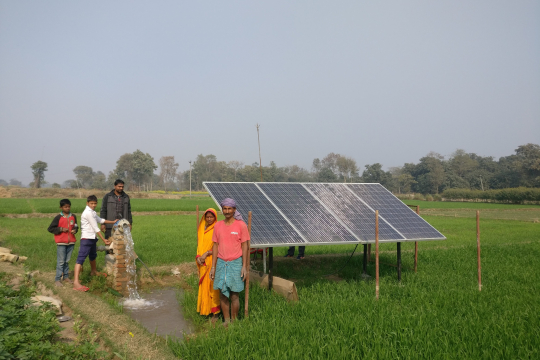A recent study found that targeted financial models and specific incentives can overcome the barriers to the use of solar irrigation pumps (SIPs) among smallholder and women farmers in Nepal.
Dipendra Bhattarai, member of EfD’s Sustainable Energy Transitions Initiative (SETI), recently published Targeted finance and the adoption of solar irrigation by smallholder and women farmers, a study based on a field experiment across 93 rural administrative units in Nepal.
Off-grid solar energy holds immense promise for low-carbon poverty alleviation, but its application has largely been limited to low-power home systems with minimal economic impact.
SIPs, on the other hand, offer a sustainable solution to expand access to irrigation without increasing harmful emissions. They are a sustainable and clean alternative, as they reduce dependence on fossil fuels and associated costs and can improve agricultural productivity by ensuring a constant and reliable water supply.
However, the adoption of SIPs has remained low, particularly among smallholder farmers and women, unless heavily subsidized. The investigation tackled this challenge by introducing targeted financing and specific incentives.
Communication channels matter
When introducing targeted financing models that provide loans to reduce the upfront cost of SIPs, a barrier that prevents smallholders from investing, 90% of these loans were repaid, showing the viability of this approach. Additionally, specific incentives led to women comprising over half of the eventual SIP adopters.
By addressing the specific needs of smallholder and women farmers, it is possible to unlock the potential of SIPs to enhance agricultural productivity, improve climate resilience, and contribute to low-carbon economic development.
Dipendra Bhattarai commented that two important aspects need to be considered. "First, how do we effectively reach marginalized groups and smallholder farming communities? The choice of communication channels is key; they must be accessible to these communities".
Findings demonstrated that if you can engage opinion leaders in marginalized or smallholder farming communities, you are more likely to reach the target groups with your message.
“Once these communities are reached, loan incentives, such as reduced interest rates, smaller loan amounts, or subsidy-linked loan schemes, can help ensure inclusion and equity. Loan programs become truly inclusive and equitable when they are designed with these targeted, community-specific strategies in mind.”
Dipendra Bhattarai explained that communicating through the right channels and tailoring the incentives are equally important to succeed with the implementation of inclusive and equitable SIP loan programs.
By Belén Pulgar.

